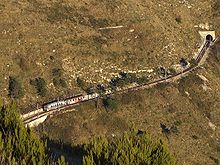Ferrovia Genova – Casella
| Genova – Casella | |||||||||||||||||||||||||||||||||||||||||||||||||||||||||||||||||||||||||||||||||||||||||||||||||
|---|---|---|---|---|---|---|---|---|---|---|---|---|---|---|---|---|---|---|---|---|---|---|---|---|---|---|---|---|---|---|---|---|---|---|---|---|---|---|---|---|---|---|---|---|---|---|---|---|---|---|---|---|---|---|---|---|---|---|---|---|---|---|---|---|---|---|---|---|---|---|---|---|---|---|---|---|---|---|---|---|---|---|---|---|---|---|---|---|---|---|---|---|---|---|---|---|---|
| Route length: | 24.318 km | ||||||||||||||||||||||||||||||||||||||||||||||||||||||||||||||||||||||||||||||||||||||||||||||||
| Gauge : | 1000 mm ( meter gauge ) | ||||||||||||||||||||||||||||||||||||||||||||||||||||||||||||||||||||||||||||||||||||||||||||||||
| Power system : | 3000 V = | ||||||||||||||||||||||||||||||||||||||||||||||||||||||||||||||||||||||||||||||||||||||||||||||||
| Maximum slope : | 45 ‰ | ||||||||||||||||||||||||||||||||||||||||||||||||||||||||||||||||||||||||||||||||||||||||||||||||
| Minimum radius : | 60 m | ||||||||||||||||||||||||||||||||||||||||||||||||||||||||||||||||||||||||||||||||||||||||||||||||
| Top speed: | 30 km / h | ||||||||||||||||||||||||||||||||||||||||||||||||||||||||||||||||||||||||||||||||||||||||||||||||
|
|||||||||||||||||||||||||||||||||||||||||||||||||||||||||||||||||||||||||||||||||||||||||||||||||
The Ferrovia Genova-Casella (FGC) ( Italian for railway Genoa-Casella ), also known as Ferrovia delle tre valli (railway of the three valleys) and Trenino di Casella (little train from Casella) , is an electrically operated meter-gauge private railway in northern Italy , which connects the Ligurian capital Genoa with the municipality of Casella in the Apennines . It was opened in 1929 and still plays an important role as a regional means of transport for the Genoa hinterland . The operating company of the formerly independent FGC has been Azienda Mobilità e Trasporti Genova SpA since April 16, 2010 .
history
The Ferrovia Genova-Casella (FGC) was created on the initiative of the people of the Ligurian Apennines in the interior of Genoa , in order to improve the connections with a useful and reliable means of transport and the long desired connection to the municipality of Casella, which was still quite remote at the beginning of the 20th century to establish the regional capital. The first groundbreaking for the construction of the railway took place on June 26, 1921, the ceremonial opening took place in 1929. In the course of time, the FGC took over frequently used rolling stock from other discontinued meter-gauge railways in Italy and partly also from abroad.
The track width of the electrically operated railway is 1000 mm ( meter gauge ), which was an exception, since the standard narrow-gauge width , which has been legally established since 1879 in what was then the Kingdom of Italy, was actually 950 mm ( Italian meter gauge ). However, the exact meter gauge was not so rarely found in northern Italy, including the Genoa tram (1878–1966) and three of the four other trams in Liguria ( Ventimiglia , Savona , Imperia ) except one ( La Spezia with 1445 mm) was built in meter gauge.
The power system used for the single-track line was initially 2400 volts direct current , but this was later brought to the standard of the state railway Ferrovie dello Stato (FS) of 3000 volts direct current. But apart from that, the FGC differs considerably from the usual practice at the FS, in addition to the track gauge, both in the designation system of the locomotives and in the operating processes and signaling devices.
The FGC is one of the few licensed narrow-gauge railways in Italy that survived the somewhat haphazard wave of decommissioning of the 1960s, especially among private railways. On the one hand, this is attributable to the very good condition of the railway, but also to the fact that there is still a lack of usable alternative transport routes between Genoa and Casella.
course
From the small Piazza Manin train station in the center of Genoa , the narrow-gauge railway leads directly into the Ligurian Apennines and crosses the three valleys Valbisagno , Valpolcevera and Valle Scrivia to Casella on its 24.318-kilometer route . It also marginally affects the Val Trebbia . The train also goes through a total of two tunnels . The municipality of Sant'Olcese is two thirds of the way and the depot in Casella is reached shortly before the end point .
The following heights are reached: The starting station in Piazza Manin is at a height of 93 meters above sea level , after nine kilometers at the Trensasco settlement, 370 meters are reached and the terminus at Casella is 410 meters. The highest point of the railway line is reached at 458 meters at the watershed of the municipality of Crocetta d'Orero . The maximum gradient on the route is 45 ‰ .
11 pairs of trains run on the route every day and carry around 250,000 passengers a year . The duration of the one-way trip is specified in the timetable as 65 minutes.
Traction vehicles
The locomotives are indicated with the following abbreviations:
EM ( electric multiple unit )
L or B ( electric locomotive )
D ( diesel locomotive )
- D1: year of construction 1964, origin: DB (ex 252 902 )
- L28-29: built in 1924, origin: railway line Adria-Apennin ( Ferrovia Sangritana ) - vehicles re-gauged from 950 mm to 1000 mm
- B51-B52: built in 1929, origin: Ferrovia della Val di Fiemme (Fleimstalbahn)
- EM A1-A3: built in 1929, origin: Ferrovia della Val di Fiemme
- EM A4-A7: built in 1957, origin: Ferrovia Spoleto-Norcia - vehicles re-tracked from 950 mm to 1000 mm
- EM A8-A10: year of construction 1993
- EM A11-A12: year of construction 1998
particularities
It is possible, with advance notice, to use railcars or even complete train units - whether historical or current - with an electric or diesel locomotive for private occasions such as B. Rent weddings or bicycle transport for small and / or large groups.
See also
Web links
- Official Homepage (Italian)
- Photo gallery at Photorail.com (Italian)
Individual evidence
- ^ Ferrovia Genova Casella. AMT, December 31, 2017, accessed December 5, 2018 (Italian).
- ↑ LokMagazin 11/2016, p. 67


